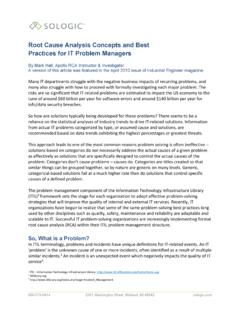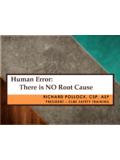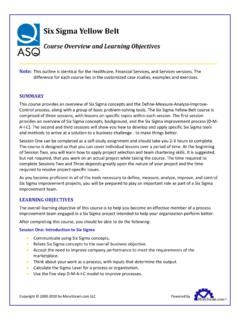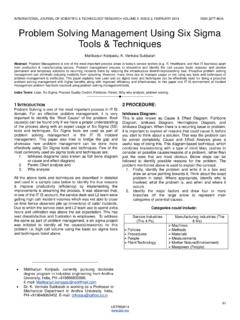Transcription of Phone: Fax: Email: Website - Continuous …
1 phone : +61 (0) 402 731 563. Fax: +61 (8) 9457 8642. email : Website : The masters of plant and equipment reliability improvement Understanding How to Use The 5-Whys for Root Cause Analysis Abstract Understanding how to use the 5-Whys for Root Cause Analysis. The 5-Why method of root cause analysis requires you to question how the sequential causes of a failure event arose and identify the cause-effect failure path. Why' is asked to find each preceding trigger until we supposedly arrive at the root cause of the incident. Unfortunately it is easy to arrive at the wrong conclusion. A Why question can be answered with multiple answers, and unless there is evidence that indicates which answer is right, you will most likely have the wrong failure path.
2 You can improve your odds of using the 5-Why method correctly if you adopt some simple rules and practices. Keywords: Five Whys, Root Cause Failure Analysis, RCFA, cause-effect tree, Fault Tree Analysis, FTA. The Five Whys approach to root cause analysis is often used for investigations into equipment failure events and workplace safety incidents. The apparent simplicity of the 5-Whys leads people to use it, but its simplicity hides the intricacy in the methodology and people can unwittingly apply it wrongly. They end up fixing problems that did not cause the failure incident and miss the problems that led to it.
3 They work on the wrong things, thinking that because they used the 5-Whys and the questions were answered, they must have found the real root cause. Description of the 5-Why RCFA Method The 5-Why method helps to determine the cause-effect relationships in a problem or a failure event. It can be used whenever the real cause of a problem or situation is not clear. Using the 5-Whys is a simple way to try solving a stated problem without a large detailed investigation requiring many resources1. When problems involve human factors this method is the least stressful on participants. It is one of the simplest investigation tools easily completed without statistical analysis.
4 Also known as a Why Tree, it is supposedly a simple form of root cause analysis. By repeatedly asking the question, Why?' you peel away layers of issues and symptoms that can lead to the root cause. Most obvious explanations have yet more underlying problems. But it is never certain that you have found the root cause unless there is real evidence to confirm it. You start with a statement of the situation and ask why it occurred. You then turn the answer to the first question into a second Why question. The next answer becomes the third Why question and so on. By refusing to be satisfied with each answer you increase the odds of finding the underlying root cause of the event.
5 Though this technique is called 5-Whys', five is a rule of thumb. You may ask more or less Whys before finding the root of a problem (there is a school of thought that 7. whys' is better; that 5 whys' is not enough to uncover the real latent truth that initiated the event). Implied in the Five Whys root cause analysis tool, though not often stated openly, is the use of a cause and effect tree known as a Why Tree. The method is also called Fault Tree Analysis. It is best to build the Why Tree first so that the interactions of causes can be seen. Sometimes only one cause sets off an event, other times multiple causes are necessary to produce an effect.
6 The Why Tree for even a simple problem can grow huge, with numerous cause-effect branches. The 5-Why method uses a Why Table to sequential list the questions and their answers. Table 1 is an example of a completed 5 Why Table for a late delivery that lost a company an important Client. 1. Some contents for this topic are from the Website C:\Users\MikeS\Documents\Lifetime Reliability\LRS Maint Methodology\Understanding How to Use The 5 Whys for Root Cause 1. phone : +61 (0) 402 731 563. Fax: +61 (8) 9457 8642. email : Website : The masters of plant and equipment reliability improvement Note how each answer becomes the next question.
7 It is vital that each Why question uses the previous answer because that creates a clear and irrefutable link between them. Only if questions and answers are linked is there certainty that an effect was due to the stated cause and thus the failure path from the event to its root is sure. 5 Why Question Table Team Members: Date: Problem Statement: On your way home from work your car stopped in the middle of the road. Estimated Total Business-Wide Cost: Taxi fare x 2 = $50, Lost 2 hours pay = $100, Order was late to Customer because Storemen did not get to work in time to despatch delivery and Customer imposed contract penalty of $25,000, Lost Customer and all future income from them, estimated to be $2 Million in the next 10 years.
8 Recommended Solution: Carry a credit card to access money when needed. Latent Issues: Putting all the money into gambling shows lack of personal control and responsibility over money. Why Questions 3W2H Answers Evidence Solution (with what, when, where, how, how much). Because it ran out of gas in a back Car stopped at side of 1. Why did the car stop? street on the way home road Because I didn't put any gas into Fuel gauge showed Contact work and get 2. Why did gas run? the car on my way to work this empty someone to pick you up morning. 3. Why didn't you buy Because I didn't have any money Wallet was empty of Keep a credit card in the gas this morning?
9 On me to buy petrol. money wallet Because last night I lost it in a 4. Why didn't you have Poker game is held poker game I played with friends at Stop going to the game any money? every Tuesday night my buddy's house. Because I am not good at 5. Why did you lose bluffing' when I don't have a good Has lost money in many Go to poker School and your money in last poker hand and the other players other poker games become better at bluffing'. night's poker game? jack-up the bets. 6. Why Table 1 A 5-Why Analysis Question Table Build the Why Tree One Cause Level at a Time Many people start into a 5-Why analysis by using the 5-Why Table.
10 With each Why question they put in an answer and then ask the next Why question. This question-and-answer tic-tac-toe continues until everyone agrees the root cause is found. Forgotten is the fact that an event can be produced by multiple causes and multiple combinations of causes. Using the Why Table alone is permitted if there is only one cause of every effect listed on the table. The logical connectivity between events and all their causes can be seen with a Why Tree. Building a Why Tree gives you a good chance of spotting all the issues that could have been in play prior to a failure event.





